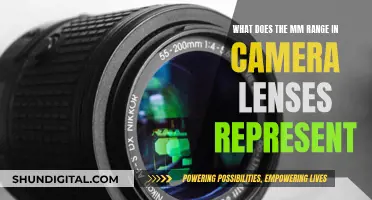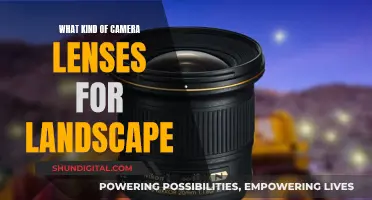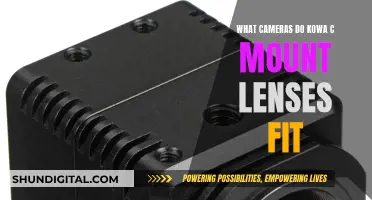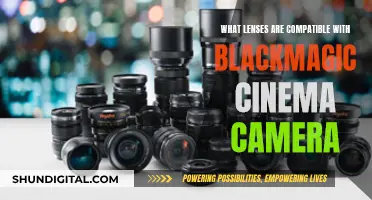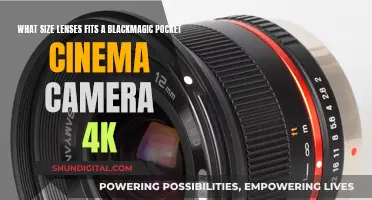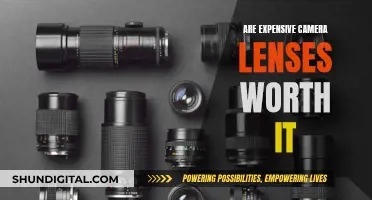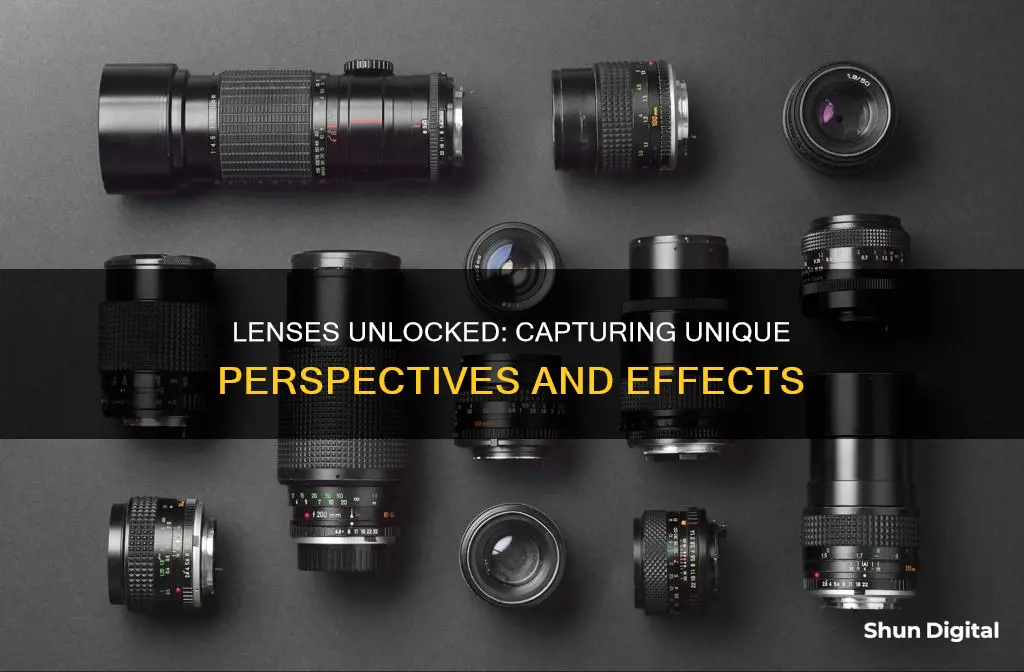
Camera lenses are an essential component of photography, as they focus light from the viewfinder into a tiny spot on the camera's sensor, enabling the capture of clear and detailed images. The market offers a wide range of lenses, which can be broadly categorised into two types: prime and zoom lenses. Prime lenses have a fixed focal length, resulting in sharper images, while zoom lenses offer variable focal lengths, providing greater flexibility in framing the shot. The choice of lens depends on the photographer's needs and preferences, with factors such as focal length, maximum aperture, and additional features like image stabilisation influencing the final decision.
| Characteristics | Values |
|---|---|
| Type | Prime, Zoom, Telephoto, Wide-angle, Super wide-angle, Macro, Fisheye, Tilt-shift |
| Focal Length | Fixed, Variable |
| Image Quality | Higher with Prime lenses |
| Framing | Zoom lenses allow for adjusting the frame without moving |
| Portability | Prime lenses are smaller and lighter |
| Cost | Prime lenses are generally cheaper |
| Flexibility | Zoom lenses offer more flexibility |
| Ease of Use | Zoom lenses are easier to use |
| Field of View | Wide-angle lenses offer a wider field of view |
| Depth of Field | Wide-angle lenses offer greater depth of field |
| Aperture | Wide aperture allows for shallow depth of field |
| Usage | Depends on the type of photography, e.g. wildlife, sports, portrait, landscape |
What You'll Learn

Prime lenses have a fixed focal length
Prime lenses have many advantages. They are often cheaper, sharper, and have wider maximum apertures than zoom lenses. They are also smaller and lighter. This is because they contain fewer glass elements than zoom lenses. Prime lenses are also finely tuned to deliver on one specific type of photography. For example, the 50mm prime lens, also known as the "Nifty Fifty", is perfect for portraits as the focal length is considered to be as close to the human eye as possible. There is very little distortion or magnification in the image. A 35mm prime lens, on the other hand, is usually used by landscape photographers.
However, the fact that prime lenses cannot zoom can be a limitation. If you want to adjust your framing of a scene, you have to move closer to or further away from your subject, or buy another prime lens with a different focal length. This can be inconvenient and costly.
Universal Camera Lenses: A Myth or Reality?
You may want to see also

Zoom lenses have variable focal lengths
Zoom lenses are a type of camera lens that offers a range of different focal lengths in a single lens. This is in contrast to prime lenses, which only offer a single focal length. Zoom lenses are described by the ratio of their longest to shortest focal lengths. For example, a zoom lens with focal lengths ranging from 100mm to 400mm may be described as a 4:1 or "4x" zoom. The convenience of variable focal length comes at the cost of complexity and some compromises on image quality, weight, dimensions, aperture, autofocus performance, and cost.
Zoom lenses are often used in still, video, and motion picture cameras, as well as projectors, binoculars, microscopes, telescopes, and other optical instruments. They provide greater flexibility in framing and composition without having to change lenses or physical positions. For example, a zoom lens can be used to quickly reframe a scene while staying in the same physical position. This can be particularly useful in travel photography, where weight and space may be limited, or in events where there may not be enough time to change lenses.
There are two main types of zoom lenses: constant-aperture and variable-aperture. Constant-aperture zoom lenses maintain the same maximum aperture throughout the entire focal range, resulting in no loss of light-gathering power as the focal length increases. This is advantageous in challenging lighting conditions, as it allows for faster shutter speeds. On the other hand, variable-aperture zoom lenses feature two F-stops, indicating the maximum aperture at the shortest and longest focal distances. As a result, the overall light-gathering power decreases as the focal length increases, leading to slower shutter speeds at longer focal lengths. However, variable-aperture zoom lenses offer more compact designs and higher zoom ratios.
When choosing a zoom lens, it is important to consider your photographic intentions, budget, and size constraints. Different zoom lenses are designed for different purposes, such as wide-angle zooms, super telephoto zoom lenses, and standard zoom lenses for everyday use. Additionally, the zoom ratio, aperture, focal length, and other factors will impact the overall performance and versatility of the lens.
Protect Your Camera Lens: Storage Tips for Photographers
You may want to see also

Wide-angle lenses are good for landscape photography
Wide-angle lenses are a landscape photographer's best friend. They allow you to capture a dramatic scene with ease, emphasising the foreground and making the background appear small. This is particularly useful when shooting landscapes as it allows you to capture a sweeping vista and dramatic skies in one frame.
The flexibility of a wide-angle zoom lens is also beneficial for landscape photography. It allows you to fine-tune your composition without having to hike over hills or move your feet, which is less practical when shooting at a distance.
Wide-angle lenses are also great for astrophotography. The wider the focal length, the longer the shutter speed you can use before stars start to trail. The '500 rule' states that the maximum shutter speed you can use before stars start to trail is 500 divided by your lens' focal length. So, a 10mm lens would allow for a maximum shutter speed of 50 seconds, compared to 10 seconds with a 50mm lens.
When choosing a wide-angle lens for landscape photography, consider the weight of the lens, its ease of use, image sharpness, and weather sealing. You might also want to look for a lens that can take screw-on filters, as filters can be important in landscape photography.
- Canon EF-S 10-22mm f/3.5-4.5 USM
- Canon EF 11-24mm f/4L USM
- Nikon AF-S 16-35mm f/4G ED VR
- Pentax DA HD 11-18mm f/2.8 ED DC AW
- Tokina Atx-I 11-20mm F2.8 CF
- Canon RF 14-35mm f/4 L IS USM
- Nikon Z 14-30mm f/4 S
- Nikon Z 14-24mm f/2.8 S
- Sony FE 12-24mm F4 G
- Sigma 16-28mm f/2.8 DG DN C
- Sony E 10-18mm F4 OSS
- Fujifilm XF 10-24mm F4 R OIS WR
- Panasonic 8-18mm f/2.8-4 ASPH Vario
- Olympus M.Zuiko Digital ED 7-14mm f/2.8 PRO
- Tamron 11-20mm f/2.8 Di III-A RXD
The High Cost of Camera Lenses: Why So Expensive?
You may want to see also

Telephoto lenses are good for wildlife photography
Telephoto lenses are ideal for wildlife photography as they allow photographers to capture images of animals from a distance without disturbing them. This is particularly useful when photographing timid or dangerous animals.
Telephoto lenses are typically lenses with a focal length of 100mm or more. The longer the focal length, the closer you can get to your subject without physically moving an inch. This is especially beneficial when photographing wildlife as it allows you to fill the frame with your subject and capture intimate shots without entering their comfort zone.
When choosing a telephoto lens for wildlife photography, consider the following:
- Focal Length: Aim for a lens with a focal length of at least 300mm to get close-up shots of wildlife.
- Aperture: A wider aperture (smaller f-number) is beneficial for low-light conditions and capturing fast-moving subjects. However, lenses with larger apertures tend to be more expensive.
- Image Stabilization: Image stabilization (IS) helps prevent blurry photos when shooting handheld, which is common in wildlife photography.
- Weight and Size: Longer and faster lenses often provide better image quality but can be heavier and bulkier, making them less ideal for hiking or travelling.
- Weather Sealing: If you plan to shoot in rugged environments, look for a lens with good weather sealing to protect against dust, moisture, and harsh conditions.
Canon EF 100-400mm f/4.5-5.6L IS II USM: This lens offers a versatile zoom range, advanced image stabilization, fast and silent autofocusing, and impressive clarity. It is also relatively affordable and compatible with Canon's extenders.
>2. Nikon AF-S Nikkor 200-500mm f/5.6E ED VR: With a focal length of 500mm on FX-format cameras and 750mm on DX-format cameras, this lens provides impressive reach. It features Extra-low Dispersion glass to reduce glare and a Silent Wave Motor for fast and quiet autofocusing.
>3. Sony FE 200-600mm f/5.6-6.3 G OSS: This lens delivers outstanding clarity, colour fidelity, and sharpness. It has a fast and precise autofocus system and is dust and moisture-resistant. It is compatible with Sony's FE teleconverters for even more reach.
>4. Tamron SP 150-600mm f/5-6.3 Di VC USD G2: This lens offers an extensive zoom range, advanced optical technology for sharp and clear images, and a fast and quiet autofocus system. It is compatible with various camera brands, including Canon and Nikon.
>5. Sigma 150-600mm f/5-6.3 DG OS HSM Contemporary: A lightweight and versatile lens that delivers sharp and high-resolution images. It has a Hyper Sonic Motor for fast and quiet autofocus and is compatible with Sigma's teleconverters.
Telephoto lenses are a great choice for wildlife photography, allowing you to capture stunning images of animals in their natural habitats without disturbing them.
Lens and Camera Compatibility: Universal Fit or Not?
You may want to see also

Macro lenses are good for close-up photography
Macro lenses are ideal for close-up photography, allowing photographers to capture images beyond what the human eye can see. They are perfect for shooting small subjects and bringing them into sharp focus, making them appear much bigger in the final image.
The versatility of macro lenses extends beyond close-up images of insects, flowers, and textures. They are also excellent for newborn photography, capturing tiny details like eyelashes, fingers, and toes. Macro lenses are also useful for product photography, especially when dealing with smaller items.
Additionally, macro lenses can be used for portrait photography. They capture intricate details, allowing you to achieve correct focus even when standing very close to the subject. Macro lenses come in focal lengths that are ideal for portraits, typically ranging from 90mm to 105mm.
When choosing a macro lens, consider the focal length and minimum focusing distance. A longer focal length results in a longer minimum focusing distance, providing more working space between you and the subject. Lenses with a focal length between 90mm and 105mm are the most popular as they strike a balance between size, weight, affordability, and minimum focus distance.
To capture steady and sharp macro images, it is essential to stabilize your shot. Using a tripod and remote triggers can help eliminate camera shake. Additionally, some macro lenses or camera bodies have built-in image stabilization, which can be useful in reducing camera shake.
When it comes to lighting, macro photography requires ample light due to the use of narrow apertures. A ring light can be a useful artificial lighting solution, providing a continuous light source without the reflections that direct lighting may cause.
In terms of aperture, a narrow aperture is often preferred in macro photography to achieve a sharper image with more of the subject in focus. Focusing can be manual or autofocus, depending on the situation. For fast-moving subjects, autofocus may be more suitable, while manual focus allows for precise adjustments.
With their ability to capture intricate details and magnify small subjects, macro lenses are a valuable addition to any photographer's kit, enabling them to explore the microscopic world and present unique and captivating imagery.
How Lenses Transform Your Camera's Vision
You may want to see also
Frequently asked questions
Prime lenses have a fixed focal length, while zoom lenses have variable focal lengths.
A standard or normal lens has a focal length of around 50mm, which is close to the human eye's field of view.
Telephoto lenses are used for wildlife, sports, and portrait photography, where the photographer needs to be a certain distance away from the subject.
Wide-angle lenses are used for landscape, architecture, and interior photography, as they have a wider field of view than the human eye and can fit more of the scene into the frame.
Macro lenses are used for close-up photography of small subjects, such as insects, flowers, or products.


